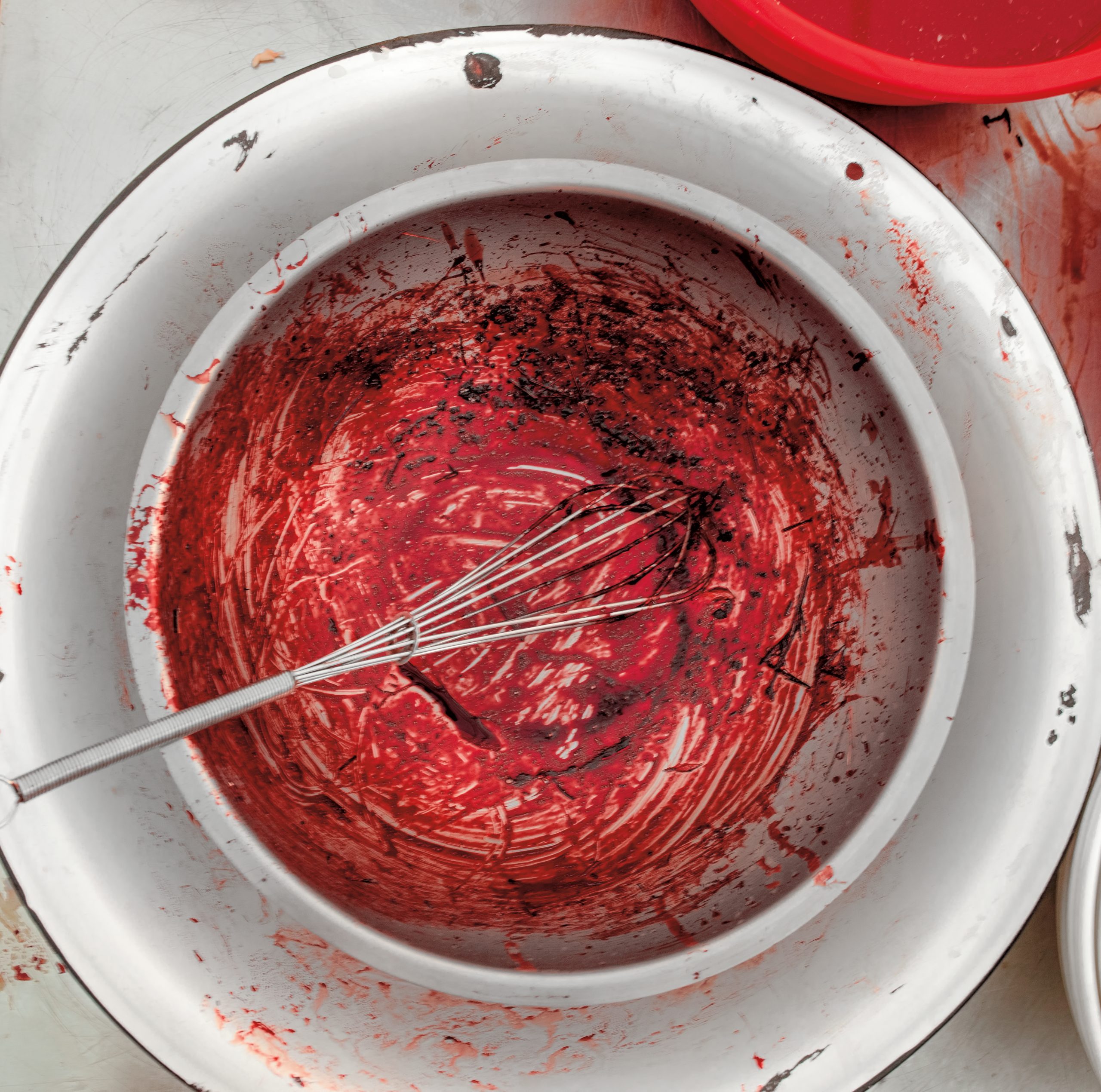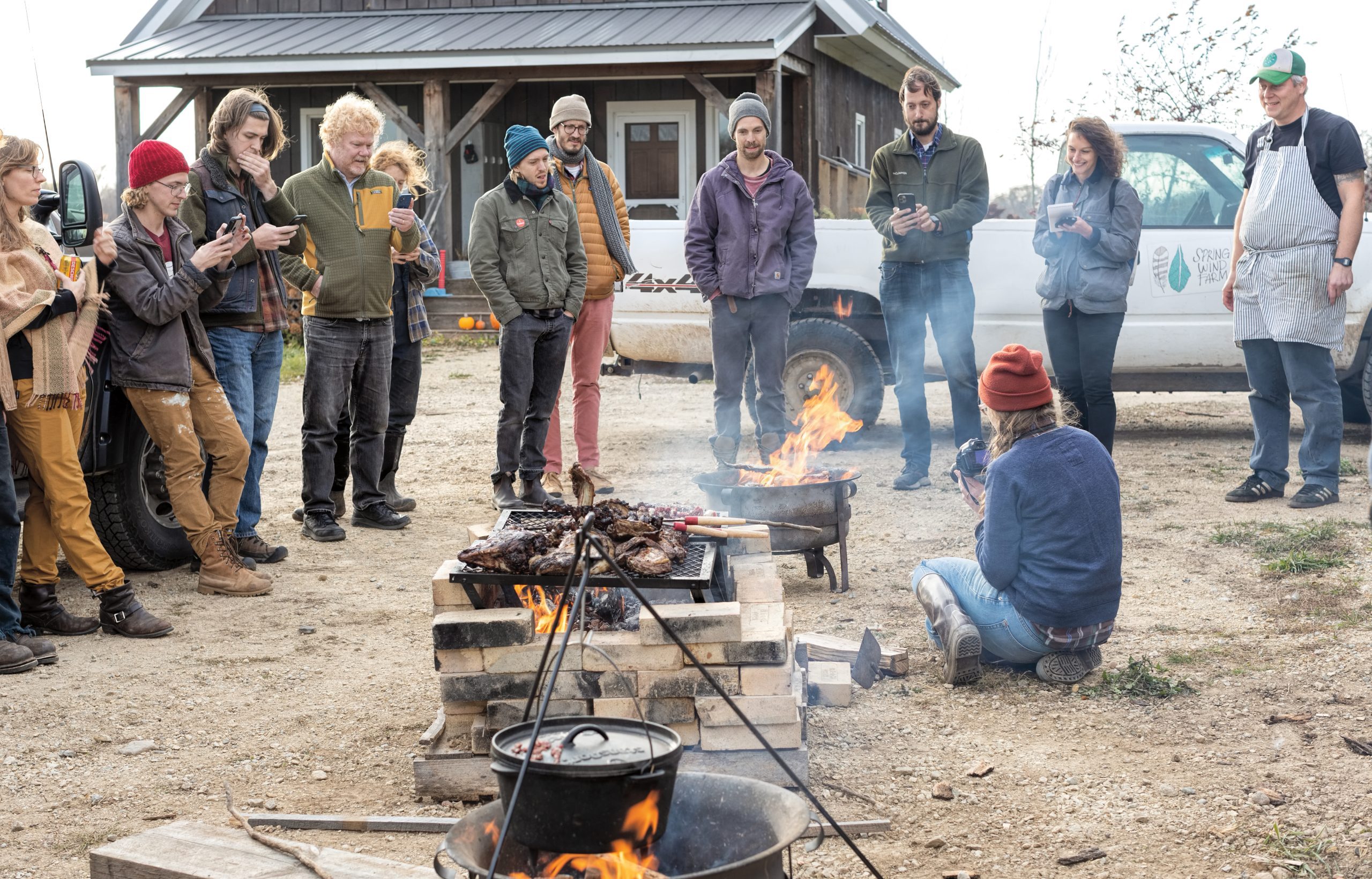A Classics professor recreates an animal sacrifice to teach modern-day students about everyday life in ancient Greece.

On a bluff at Spring Wind Farm just outside Northfield’s town limits, Jake Morton is preparing to feast with the gods.
It’s November, both harvest time in Minnesota and the time that, between about 700–400 BCE, shepherds in Greece would move their flocks. Morton, an assistant professor in the classics department, an erstwhile chef, and an experimental archeologist, says it’s the perfect time to merge the ancient and the modern world. It’s also the appropriate time to give thanks and ask for another fruitful year.
Students, professors, and friends look on as Morton expertly wields a small, curved knife to divide a sacrificial lamb — slaughtered just a few hours before — into its constituent pieces. Lester, a black and white farm cat, prowls underfoot, sticking his battle-scarred nose into a bin of cast-off gristle, looking for a snack. Morton carefully dissects the thigh bone, wrapping it twice in the caul fat that once lined the outside of this lamb’s organs and which now resembles a delicately latticed cable-knit blanket.
Students arrange the kidneys, spleen, and liver on long skewers and calculate the proper ratio of wine to stew meat. Once the ribs are grilling and a cauldron full of onions, lamb, and wine is gurgling over the fire, Morton is ready to teach.
He places the fat-wrapped thigh bone and the tail on the fire. If it makes a burst of flame and if the tail curls up, that means the gods heard our prayers, he explains. “And if it doesn’t go, the gods are wicked pissed! So you should be freakin’ out.”
The air is redolent with wood-smoke and meat. The fire crackles and the wind howls as a group of Carls wait to see if the gods are listening.

Food gave Morton a window into the ancient world, even before he was an academic. A college dropout turned professional chef living in Montana, he became fascinated by ancient Greek recipes and even staged a thematic feast at the restaurant where he worked. That enthusiastic curiosity drove him to get an undergraduate degree in Latin and ultimately pursue a doctorate in ancient history at the University of Pennsylvania.
But even as he’s strayed far from the kitchen, food has remained a focus of his work. “As a scholar, I think food is a great way to get at people’s daily lives,” Morton says.
He’s also found that occasionally bringing a culinary sensibility into the classroom can add depth to more traditional curriculum. In Morton’s Experimental Archaeology and Experiential History course, which is co-taught with history lecturer Austin Mason and culminates in the November ceremony, students follow ancient recipes for making cheese and flatbread. They also learn how to make string and then weave it into cloth. Classics major Sam Wege ’22 valued the class because it gave him a better sense of how ordinary people from the period might’ve spent their days. “One of the biggest things that’s omitted from the historical record is the mundane things that take a ton of time,” he says.
The hands-on approach can also lend an immediacy to ancient texts. In the Odyssey, for example, Penelope spends much of her time weaving, unraveling, and reweaving her shroud. Learning how to actually make cloth helped classics major MJ Fielder-Jellsey ’22 appreciate what’s happening in those scenes. “It definitely put that in a real context of, ‘Oh, I physically understand how she is doing this,’ ” she says.
Although animal sacrifices weren’t daily occurrences, they were central events in ancient Greece: part spiritual connection, part nutritional necessity, and part wild celebration. Animals would be paraded through town before being slaughtered. Then members of the community would quickly remove the thigh bone, caul fat, and tail for the sacrifice. While the gods dined on knise — a much beloved if mysterious substance that is both the burning fat and bone and some other, intangible element — their human worshippers feasted on the organ meat, called splankna, and on a stew made with wine and the rest of the meat. “People now think sacrifice means to deprive yourself of something, but it’s not,” says Morton. “It’s a party, man.”
For ancient people, who subsisted largely on porridge, a rich stew and a surfeit of wine was a big deal — a moment of deep bonding for the community. The experience also served as an unmediated interaction with the divine. “You’re actually sharing the meal with the gods,” Morton explains. It’s an intimate and powerful kind of relationship. And because the curled tail is such an unmistakable sign, it can be interpreted by anyone. No need for a priest to reveal the results. That doesn’t mean the gods will grant your wish, but it’s a direct signal that they heard you. “That’s an incredible moment that I never get in 2021,” he says.
Morton began experimenting in earnest as a fellow at the American School of Classical Studies at Athens, purchasing a lamb leg at the city’s central market and performing sacrifices on Saturday afternoons. He consulted ancient texts and studied decorations on vases that depicted these rituals to see how the fat and meat hung on the lamb leg, used his butchering and cooking skills to approximate the right cut, and pored over ancient descriptions of the stews people ate, titrating the right mixture of wine to meat. “You don’t want it to be so thick that you have to stir it a lot because it’s on an open fire,” he says, pointing out that too much wine will yield a thin and disappointing soup. Finally, recreating the process over and over showed him how dramatic the cone of fire and tail curl are. “It really emphasized to me the theatrical component of the whole thing.”
Since coming to Carleton in 2018, Morton has enlisted the help of students in his experimental archeology classes, who set up their own mini-sacrifices burning beef femurs. Each group keeps careful track of the temperature of the fire and times how long it takes for the burst of flame and the tail curl. Morton is including data collected by the spring 2021 class in a forthcoming paper on rituals performed at the palace at Pylos in southwestern Greece.
Clara Hardy, the David and Marian Adams Bryn-Jones Distinguished Teaching Professor of the Humanities and a professor of classics, points out that it’s standard for science students to help professors gather data and do research. Giving humanities students that opportunity is a valuable experience for the students and provides real, tangible help to professors, too, says Hardy.

At this year’s sacrifice, tension is building. The tail has blackened, but there’s been no movement. Yet.
The fire grows, though the strong wind whipping over the grill makes the cone of flame less visible. The crowd grows quiet (Morton loves watching the worry build among onlookers.) After what feels like a freighted eternity, the charred tendons contract and the tail arches proudly like a scorpion rising from the grill. The group breathes a collective sigh, awash in relief.
Morton enlists some of the students to roast the organs and someone else to scatter barley, a grain offering, onto the fire. “Congratulations, you’re a pagan,” says someone in the crowd. Another student dips sheaves of dried wheat into fresh lamb’s blood and shakes it onto the flames. The blood is so fresh and so red it looks fake. Classics major Alex Harrison ’22, a sacrifice first-timer, came for a once-in-a-lifetime opportunity. Brandishing a skewer of kidneys, he proclaims, “it was a lot of fun,” and proudly shows off the blood speckles on his boots.
After the event, Morton confesses that there’s one enduring lesson he’s learned over the years, but prefers to keep a secret until the end of each class: “It’s basic science that if you put a tail on fire the tendons contract and it curls. And if you put a bunch of fat on a fire, it’s going to catch on fire. It works every time.”
Morton’s gained other unquantifiable insights, as well. He knows that for ancient Greeks the smell of religion is the scent of wine quenching a wood fire, just as the odor of blown-out candles instantly summons Shabbat for him. He knows that braising lamb and onion in nothing but wine yields a deep, rich, delicious stew and that students rarely resist a chance to try fresh splankna.
Students tentatively nibble on slices of kidneys, liver, heart, and spleen. Morton ladles out bowls of stew and sets out a bin for leftover bones, which he’ll bury in the Arb and exhume next year with a different class so they can simulate what it would be like to find such a stash on a dig. Fielder-Jellsey, normally a vegetarian, spreads some of the lamb brains on a piece of bread and takes a bite. “I have every day to be vegetarian,” she says before allowing that meat-eating is part of the experience. It is also, she confesses, “annoyingly delicious.”
Even Lester the cat gets to join the feast, licking melted fat off a cutting board as the sun sets over the prairie.
